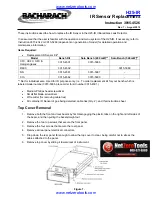
AT-G-DETECT
Gas Sensing System
LEAK DETECTION SOLUTIONS
2
B. TRICAL RESET / BUMP TEST (EVERY YEAR)
Electrical reset is based on the calibration found on the label on the side of the enclosure and is
unique to that sensor.
TOOLS REQUIRED
• A voltmeter – crocodile clips recommended
• Aquilar’s set point values, as shown on the rating label
• Estimate 10 minutes per sensor
C. ELECTRICAL RESET OF 1 LEVEL SYSTEM
Reset, if necessary, the Standby and Alarm
Threshold Voltage to the factory settings as
shown on the calibration label.
First disable the 3 minute alarm delay on a
one level system by moving the jumper link
at JP1 to the “OFF” position, diagram 1.
Two adjustments are required and they are
all performed on the controller unit.
For Sensor Standby Voltage, connect your
DC voltmeter between 4(0V) and 2(+V) on
CN1, CN2, etc as shown in Diagram 1 and
adjusting pot P1 for channel 1, P2 for channel
2, etc.For Alarm Threshold Voltage, connect
your DC voltmeter between 4(0V) and 1(+V)
on cal header as shown in Diagram 1 and
adjusting pot P3 for 1/2channel units and P7
for 4/6 channel units. For CO2 1 Level units
there is only one adjustment - the alarm
level, as the SSV is
fi
xed. This can be adjusted
by connecting your DC voltmeter between
4(0V) and 1(+V) on cal header as shown
in Diagram 1 and adjusting pot P3 for 1/2
channel units and P7 for 4/6 channel units.
Carry out a bump test to ensure the sensor is
functioning correctly. If the sensor does not
go into alarm carry out a gas calibration.
If the factory set point information is not
on the calibration label (as with older units)
check the serial number of your gas detector
on the rating label and sensor PCB and
contact Aquilar for the appropriate set point
values. Finally return the jumper JP1 to the
original position.
C. ELECTRICAL RESET OF 2 LEVEL SYSTEM
Reset, if necessary, the Standby and low /
high Alarm Threshold Voltages to the factory
settings as shown on the calibration label.
For Standby voltage, connect your DC
voltmeter between TP5 (0V) and TP4 (+V) as
shown in Diagram 2 and adjusting pot RV1.
For low-level alarm voltage, connect your DC
voltmeter between TP5 (0V) and TP2 (+V) as
shown in Diagram 2 and adjusting pot P8.
For high-level alarm voltage, connect your DC
voltmeter between TP5 (0V)and TP1 (+V) as
shown in Diagram 2 and adjusting pot P7.
For CO2 2 level units there are 2 adjustments
for the alarm levels, again the SSV is
fi
xed
and these can be found on the controller.
They can be adjusted by connecting your DC
voltmeter to the cal header between 4(0V)
and 2(+V) low alarm and adjusting P8 and for
high alarm between 4(0V) and 1(+V) adjusting
P7. If the sensor does not go into alarm
exchange the sensor and carry out a gas
calibration.If the factory set point information
is not on the calibration label (as with older
units) check the serial number of your gas
detector on the rating label and sensor PCB
and contact Aquilar for the appropriate set
point values.
Unit 30, Lawson Hunt Industrial Park,
Broadbridge Heath, Horsham, West Sussex,
RH12 3JR
+44 (0) 1403 216100
info@aquilar.co.uk
www.aquilar.co.uk



























